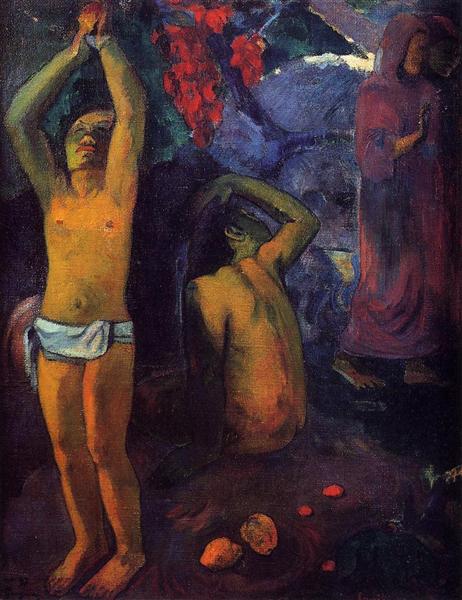תיאור
Paul Gauguin's 1897 painting "Tahitian Man with Raised Arms" stands as a brilliant example of the symbolism and exploration of Polynesian culture that characterize the artist's mature period. Gauguin, who decided to leave Europe for Tahiti in search of a more authentic and primitive life, employs his unique post-impressionist style in this work, which fuses symbolic form with a vibrant color palette.
At the center of the composition, the Tahitian man stands with his arms raised, a posture evoking both celebration and invocation. His muscular body and serene expression suggest a deep connection with the nature around him, aligning with Gauguin’s interests in indigenous spirituality and primitive art. The painting’s background, a dissonance of trees and tropical vegetation, not only frames the main figure, but also complements the sense of isolation and freedom that the artist is trying to capture. The choice of a natural context highlights the influence of the local culture, where harmony with the environment is fundamental.
Gauguin uses a bold, non-naturalistic treatment of color, applying vibrant, intense hues that inject emotion into the work. The green leaves, the blue shadows, and the man’s skin, subtly modeled in terracotta tones, create an almost dreamlike effect. This unconventional technique of color application, which rejects realism, is a hallmark of Gauguin’s approach, which aimed to express the essence of his subject rather than simply replicate nature. Through this choice, the artist transforms an everyday scene into a moment of transcendence and meaning, elevating the Tahitian man to an almost mythical figure.
It is interesting to note that during this time, Gauguin was in a moment of deep personal and artistic exploration. His stay in Tahiti was not only a physical journey, but also a search for a purer identity, away from the influences and conventions of contemporary Europe. The Tahitian men and women, often portrayed in his work, symbolized an ideal of primitive beauty and authenticity that challenged the artistic and social norms of his time.
In the context of his work, "Tahitian Man with Arms Raised" is in dialogue with other works from the same period, such as "La Orana Maria", where Gauguin also explores the relationship between humans and the natural environment. In both pieces, the artist seeks to express a vision of the world that goes beyond the physical, inviting the viewer to reflect on spirituality and connection with the environment.
This work, like many of Gauguin's creations, transcends its time, offering a glimpse not only into Tahitian culture, but also into the search for knowledge and meaning that many modern and contemporary artists have continued to explore. "Tahitian Man with Arms Raised" thus establishes itself as a beacon of Post-Impressionism, revealing the complexity of human emotions and the desire to find one's place in the world, all through the distinctive eye of one of the great masters of painting.
KUADROS ©, a famous painting on your wall.
Hand-made oil painting reproductions, with the quality of professional artists and the distinctive seal of KUADROS ©.
Painting reproduction service with satisfaction guarantee. If you are not completely satisfied with the replica of your painting, we will refund 100% of your money.

